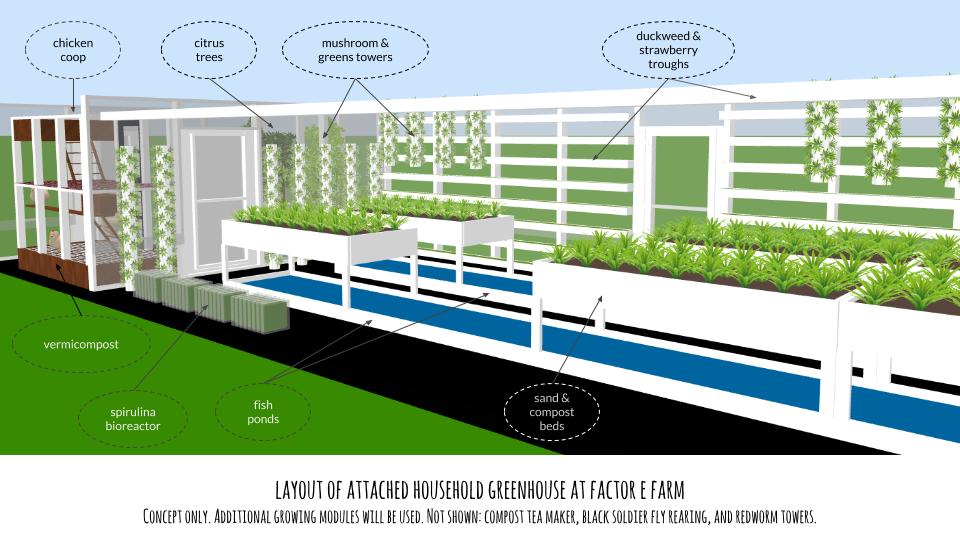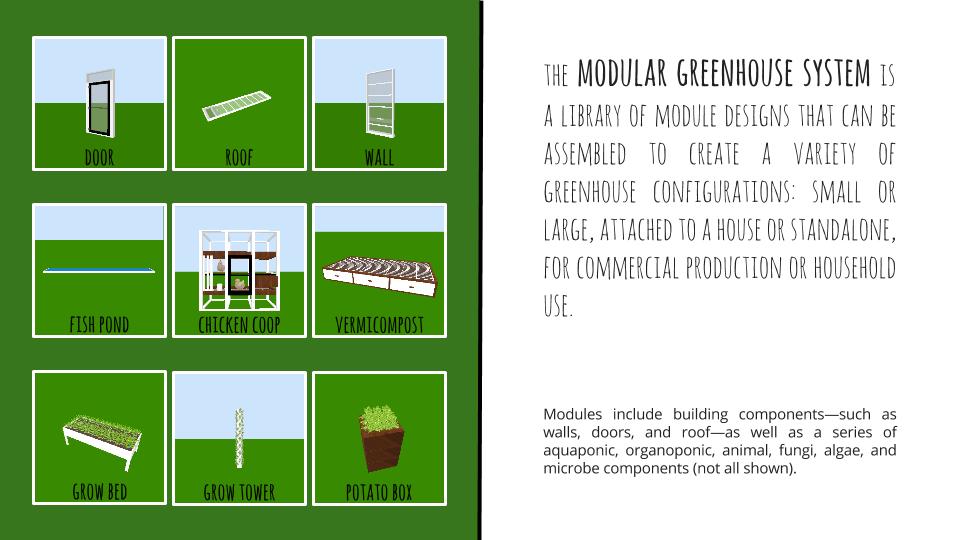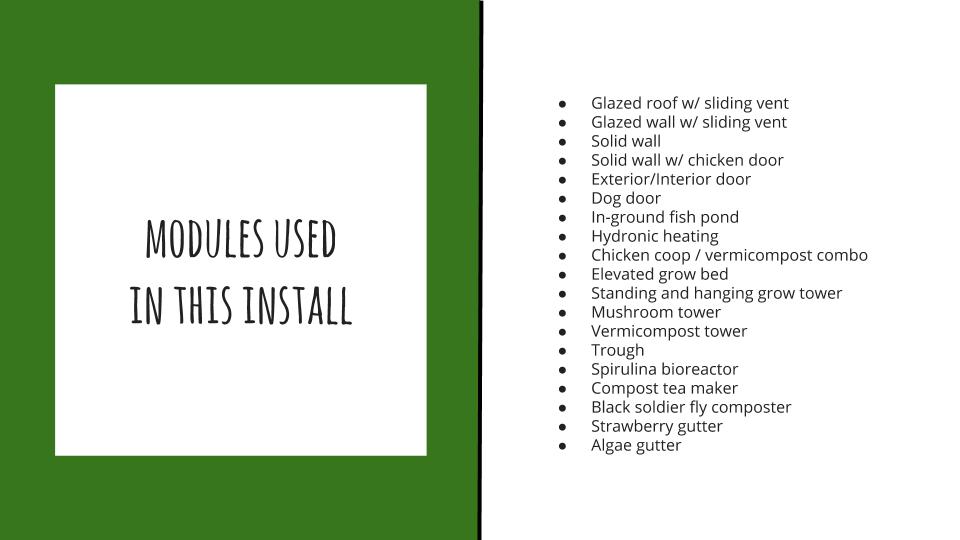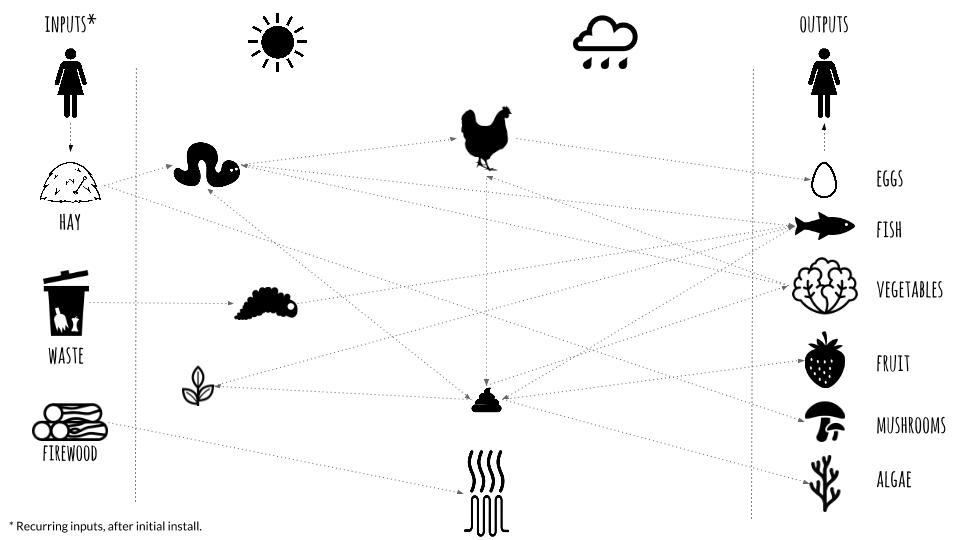Open Source Aquaponic Greenhouse from Open Source Ecology on Vimeo.
November 6-11, 2015.
November 6-8: Structure Build
November 9-11: Biological Systems Build
Maysville, Missouri, USA
Build Yourself. Build Your World.
The Open Source Ecology Aquaponics Workshop is a 6 day immersion experience where we build Open Source Ecology’s largest weeked construction project – an 800 square foot aquaponic greenhouse. The overall workshop is broken into two 3-day sessions, where participants can choose either or both. In the first workshop, we will build the greenhouse structure with polycarbonate double-wall glazing, with ponds and hydronic heating, at a cost of $4000 – or 3x lower than industry standards. In the second workshop – we will build the integrated biological modules for an integrated greenhouse with ecological pest management. This is another workshop where OSE is pioneering its Extreme Manufacturing approach of rapid building with multiple teams working in parallel on modular components. We are aiming for the most integrated, yet practical and affordable, greenhouse in the world.
In this workshop, we will push the limits of rapid building together with diverse ecological integration. Participants will gain an appreciation for the productivity that happens when modular design is used, such that the multiple components – both mechanical and biological – can be assembled rapidly from open source blueprints, like IKEA furniture. This is an example of the radical modularity that OSE is pioneering, just like we are applying to the heavy machines of the Global Village Construction Set:
The greenhouse structure consists of building roof, wall, and door panels – 37 panels in total – with openable vent windows. The glazing material is double-wall polycarbonate. The two ponds are 3’ by 30’ long, and 3 feet deep – for approximately 5000 gallons of fish area. The greenhouse will be heated by hydronic tubes running through the ponds, so participants can learn about effective in-ground heat systems
The biological systems that contribute to a diet and are included in the build:
- Grow beds for plants and fish: Plants are fed by the fish water. We will utilize sand beds, hanging towers with growing media, compost beds, and other growing tower systems.
- Strawberry gutters: Strawberries grow from ceiling-hung gutters, as a small fruit that can be grown effectively in aquaponics.
- Duckweed production: Duckweed is a primary producer low on the food chain, providing 3 kg of wet duckweed fish food per day from hanging troughs.
- Spirulina algae: A superfood that produces 10 grams of dry mass per day per square meter of growing area – our systems will produce about 100 grams of per day from the spirulina bioreactor. The bioreactor will consist of 3 square meters of water troughs and 7 more square meters equivalent from transparent panels hanging above. This is 300 calories and more that 100% of the recommended daily intake of protein for one person!
- Mushrooms: Oyster mushrooms are grown on straw in vertical towers consisting of stacked 5-gallon buckets. This produces 5 lb mushroooms per bucket or about 30 lb per tower per month – on a floor space of 1 square foot – so an average of 1 lb of mushrooms per day from 1 square foot! The CO2 produced by mushroom respiration enhaces plant growth in the greenhouse. If we have 4 towers, we have 4 lbs of mushrooms per day – 640 calories.
- Black soldier fly (BSF) larvae: Fed on kitchen scraps and offal from a local butcher shop, these can provide 5 lb of BSF larvae fish and chicken food per day from a footprint of only one square meter! That would make for about 3000 calories if you ate BSF larvae directly – or half of that if converted into fish, with a 2:1 feed conversion ratio.
- Chickens and redworms: Chickens provide eggs. If we set up redworm composting under them, how much of a chicken’s diet can be provided from worms that feed on chicken droppings? 5 eggs from our 5-chicken cage are 400 calories.
- Aerated compost tea: Biological pest control includes spraying compost tea – a brew of beneficial microbes, fungi, and protozoa – on growing plants. We will build a 55 gallon compost tea maker in this workshop. Together with beneficial insects, banker plants that attract insects, companion plants, and hedgehogs for slugs and snails – we will manage various pests without chemical sprays.
- Biotope: This is planned for the future as an important addition to the ecology of housing, but will not be built during the workshop. This is a structure outside of the greenhouse that attracts beneficial animals: wasps, frogs, snakes, bats, and bees. Bats eat large quantities of insects, and deposit them for us in the form of a fertilizer: bat guano. The bees collect nectar from miles around. Using biological bee keeping methods (top bar hive), we can harvest honey by opening the beehive once per year. Average honey crop is 40 lb, so about 1/10 lb per day – 150 calories per day! The important thing about bees is also that bee pollen could be collected, which is a superfood just like Spirulina.
Our system will produces 2850 calories per day from fish, chicken, spirulina, mushroom, and BSF – not counting any of the vegetable crops – which is enough food for a complete diet for one person. This does not include any of the ve. This is not counting any of the vegetables and fruits in the growing beds and towers! Combined with the system outside the greenhouse – a chestnut grove, hazelnuts, edible landscape, and outdoor raised beds – there is the opportunity for a house that produces all the food for its inhabitants even on the scale of an urban 1/4 acre lot.
The goal of OSE’s integrated aquaponic greenhouse build is to demonstrate the limits of what can be produced by a smart, affordable, and practical design. We are optimizing for minimum inputs. What fraction of calories, and what fraction of nutrition – can an 800 square foot greenhouse provide in practice? We will engage in a 1 year personal experiment to determine how much is possible and practical. We will document the progress and the challenges encountered to determine a practical limit. If we limit allowable maintenance time to 15 minutes per person per day – can we achieve the full system as described?
Workshop immersion involves concept and practice, and includes a crash course in carpentry skills. Participants become engaged in a part of OSE’s development process, where we produce open source blueprints for the infrastructures of civilization. Participants are introduced to basic principles of collaborative literacy – how the collaborative mindset can be used to solve wicked problems.
This workshop is intended for people interested in immersion, hands-on skills training and practical results. This immersion course may be especially useful to people who would like to master their own livelihood as responsible stewards of the land. We are especially seeking participants with an entrepreneurial mindset to expand open source aquaponics into the mainstream of home food production.
We are inviting those individuals who are interested in learning about aquaponics, and those who are considering aquaponics greenhouses or local food production as a business. We are explicitly calling out social entrepreneurs interested in starting open source aquaponics enterprises, where the collaborative efforts of many enterprises contribute to a constantly improving enterprise ecosystem. Because the aquaponics greenhouse is complex in terms of many moving parts, we think that open source collaboration is necessary for the improvements needed to make ecological aquaponics systems robust and productive – while using integrated pest management and local resources as much as possible. To help spread this work, we are also inviting dedicated documenters and videographers to participate in the event – email us to discuss the requirements.
The overall workshop is designed for people interested in transitioning from Zero to Steward and Maker. We welcome both complete novices and those with experience, as those with experience will also learn a number of skills. The critical part is willingness to learn. There are 3 tracks offered in this workshop:
- Aquaponic Greenhouse Structure (Nov 6-8): Extreme Build of a 800 square foot greenhouse with pond over a weekend.
- Integrated Biological Systems (Nov 9-11): Build and install the biological systems: plants, fish, mushrooms, spirulina bioreactor, chickens, redworms, black soldier fly larvae, duckweed, and heat-producing compost, and compost tea production.
- Both Workshops (Nov 6-11): Complete 6 day workshop – both the Structure and Biological Systems of the aquaponic greenhouse.
Have questions? Drop us an email: info at opensourceecology dot org
Instructors
- Marcin Jakubowski – Marcin was trained as a fusion physicist. He left academia right after finishing his Ph.D. to start a farm – in Missouri. For the last 7 years, he has been working on the Global Village Construction Set – a set of enabling tools and machines for building regenerative infrastructures. Marcin is passionate about creating the Open Source Economy – a new operating system for Earth. See Marcin’s bio.
- Catarina Mota – Catarina is co-founder of Open Materials (do-it-yourself smart materials), Everywhere Tech (open source technology transfer), and AltLab (Lisbon’s hackerspace). Catarina recently finished her PhD dissertation on open and collaborative practices for the development of physical goods and technologies. She is currently a Research Chair at the Open Source Hardware Association and a TED Fellow. Previously, she co-chaired the Open Hardware Summit 2012, served on the board of directors of the Open Source Hardware Association, taught as an adjunct faculty member at ITP-NYU, and was a fellow of the National Science and Technology Foundation of Portugal. Catarina’s new initiative is the Open Building Institute, with a mission to bring affordable, open source construction to the world.
- Peter McCoy A self-taught mycologist with over 14 years of accumulated study and experience, Peter is an original founder of Radical Mycology, a grassroots organization and open-source movement that teaches the skills needed to work with mushrooms and other fungi for personal, societal, and ecological resilience. Peter is the lead cultivation expert for the Amazon Mycorenewal Project and Open Source Ecology. Apart from his work with fungi, he is also a community organizer, street medic, zinester, artist, musician, lecturer, and teacher.
.
Remote Instructors
We will have the following sessions in the form of teleconference live feed.
- Ron Whitehurst Ron is a pioneer in Ecologically-Based Pest Management, and a principal at Rincon-Vitova Insectaries. Rincon-Vitova has pioneered the use of biological controls in the 1960s, and remains a leader in the field. Ron has been involved with organic methods for almost 30 years, and his book, Reading Weeds as Soil Indicators is a database in need of some updating but still ahead of its time. Ron will cover the basic principles of integrated pest management (IPM), and the specific best practices for pest management for the 15 crops of OSE’s aquaponic greenhouse.
Modular Greehnouse Design and Build
- How to design and build a modular greenhouse
- Basic construction skills and framing
- Modular design and build of walls, roofs, windows, and doors
- Building of in-ground ponds
- Greenhouse cost estimation, and how to build a modular greenhouse at 1/3 the cost of industry standards
- Solar design, heating, lighting, and ventillation
- Design and build of rainwater catchment system
- Introduction to the Open Building Institute
Aquaponics and Living Systems Systems – Design and Build
- Yield calculations of selected crops and relation to dietary needs
- Design and install of hydronic heating for the fish system
- Design and build of hanging and standing grow towers
- Designing and build of sand beds, organoponic beds, and compost growing beds
- Build of an aerated compost tea reactor and using soil food web theory and practice
- Design and build of an aquaponics control panel and Internet of Things monitoring system
- Design and build of a Spirulina algae production system
- Design and build of a Black Soldier Fly (BSF) larva production system; BSF rearing for continuity of the population
- Design and build of a worm tower to produce worm castings and redworms for fish and chicken food
- Design of an integrated chicken and redworm house that feeds the chickens and processes their waste
- Basics of mushroom spawn production to achieve sterile culture in a low-tech environment
- Oyster mushroom tower design and build
- Design and build of aquaponic strawberries grown in a hanging gutter system
- Design of tillapia rearing, growing, and harvesting system. Inoculation of ponds and starting of fish growing in tanks.
- Preparing compost-based growing medium, seeding and planting of 15 crops
- Integrated pest management design and install for the 15 crops of the greenhouse.
Note: schedule is being refined and may change slightly.
Phase 1: Greenhouse Structure
Day 1: Modular Greenhouse Build: Wall Sections
- 8AM-9: OSE Introduction
- 9-10: Aquaponic Greenhouse Overview
- 10-12: Beginning of Wall Module carpentry lessons and building
- Lunch
- 1-3: Continuing to build Wall, Door, and Window Modules. Begin installing Wall Modules
- 3-3:30: Break
- 3:30-7: Finishing wall build
- 7: Dinner and Discussion Session
Day 2 – Modular Greenhouse Build: Roof Sections
- 8 AM: Design and workflow presentation
- 8:30-12: Building and installing Roof Modules.
- Lunch
- 1-3: Afternoon build session
- 3-3:30: Break
- 3:30-7: Roof build completion
- 7: Dinner and discussion
Day 3 – Modular Greenhouse: Fish Tanks
- 8AM: Design and workflow presentation
- 8:30-12: Fish Tank construction
- Lunch
- 1-3: Afternoon build session
- 3-3:30: Break
- 3:30-7: Fish Tank completion
- 7: Dinner and closing discussion
Phase 2: Biological Systems
Learn how to build biological modules for an integrated Aquaponics Food and Heat Producing Greenhouse.
Day 1: Biological Systems: Grow Beds and Towers, Compost, Compost Tea, Soil Food Web, and Thermal Composting
- 8AM-9: OSE introduction
- 9-10: Aquaponic greenhouse Ecological Systems overview
- 10-12: Grow beds build – organoponic, compost, hanging towers, and sand beds
- Lunch
- 1-3: Soil Food Web and Compost Tea: build of 55 gallon aerated compost tea brewer
- 3-3:30: Break
- 3:30-7: Finishing Compost Tea Brewer, and Install of Thermal Composting Piles
- 7: Dinner and discussion
Day 2 – Biological Systems: Biological Pest Control, Automation and Monitoring, Mushroom Towers
- 8AM: Biological Pest Control with Ron Whitehurst
- 9-10:30: Planting crops and installing biological controls for 15 crops
- 10:30-12Build of Aquaponics Control Panel and Remote Monitoring Systems
- Lunch
- 1-3: Finishing Control Panel and Remote Monitoring
- 3-3:30: Break
- 3:30-7: Open Source Mushroom Towers: from culturing the mycelium, to spawn generation, to a mushroom tower build with Peter McCoy
- 7: Dinner and discussion
Day 3 – Biological Systems: Fish, Chickens, Vermipost Towers, Black Soldier Fly, Duckweed, and Algae Bioreactor
- 8AM: Fish System preparation and install
- 10: Build of Chicken House with Vermiposting
- Lunch
- 1-3: Build and install of Black Soldier Fly production system
- 3-3:30: Break
- 3:30-5:30: Worm Tower and Duckweed Trough Build
- 5:30-7: Spirulina Bioreactor Build
- 7: Dinner and closing discussion
Workshop 1 – Early Bird* Registration Fee for 3-day Aquaponics Workshop – Greenhouse Structure Build: $300
Workshop 2 – Early Bird* Registration Fee for 3-day Aquaponics Workshop – Biological Systems Build: $300
Early Bird* Registration Fee for Both Workshops: $500
Early Bird Registration Fee for a Single Day: $120
*Early Bird Admission ends on Friday, October 16, at 7 PM CST USA time . The registration goes up by $50 after that.
Sponsor another participant: Sponsor $300 or $500 to fund attendance of someone who is on the waiting list for financial assistance by making a donation.
Discounts for Students and Low Income Individuals: If you are a student or in need, your cost is 50% off for any of the options. If this is still beyond your means, we can consider Work Exchange, where you stay an extra day to help with site preparation and cleanup. You pay a deep discounted rate. Email us for details.
Early Bird 2-for-1 Discounts: Bring a family member or friend with you for free. 2-for-1 discount ends on Friday, October 16, at 7 PM CST USA time.
Group Rate: If you can bring a group of 3 or more people including you – we can give you a discount. Email us for details.
True Fans of OSE: As supporting members of OSE, True Fans receive a 25% discount on all of our workshops – on top of the discounts above. You can sign up as a True Fan now to become eligible for the True Fans discount on future workshops.
Donate to OSE: We are a nonprofit organization with 501(c)3 status. You can make tax-deductible contributions to us.
Workshop fee includes workshop tuition. We can pick you up from the airport, Kansas City International (about an hour away). Participants may secure a hotel in Cameron, Missouri, (15 miles away). We have 18 spots for participants who want to stay in our shared dorm room accommodations. We also have primitive camping on site which includes a composting toilet. Showers and a bathroom are located in our main house, HabLab. Meals will be done as a combination of catered dinner and potluck lunch. For lunch – bring your own or bring some to share. OSE will provide continental breakfast make-your-own sandwiches for lunch, and catered dinner. A kitchen is available for basic food preparation. Our accommodations are rough, so if you want a more comfortable stay, we recommend that you get a hotel. Our dorm rooms may be noisy due to late night conversations by participants. Please remember that we are an experimental facility that is permanently under construction, so please gauge your expectations accordingly.
Payment Options: PayPal, Credit Card, Dwolla, Bitcoin, Check, Money Order, or Cash
Registration for the choices above is found on Eventbrite, but Eventbrite accepts only PayPal or Credit Card. If you would like to pay by other means you can select that option at Eventbrite, but then you have to submit your payment independently of Eventbrite. We accept Dwolla, Bitcoin, Check, Money Order, or Cash. Your registration is complete upon receipt of payment. If you pay with Dwolla – Dwolla charges lower transaction costs than PayPal. If you are paying by Dwolla, register at Eventbrite and select the Dwolla option, then pay independently via Dwolla (Dwolla is not currently integrated into Eventbrite). Use Open Source Ecology or ops@opensourceecology.org as the Dwolla recipient. Bitcoin is a decentralized payment system. You can pay via a bitcoin amount translated by the current bitcoin exchange rate on the day that you register. OSE’s Bitcoin Address is 166yC48RakrZdtsBj36vY9q29CpzknHbxY. If you are paying by check, please make checks payable to Open Source Ecology. Our mailing address is OSE, 909 SW Willow Rd, Maysville, MO 64469. For mailings, please write “Aquaponics Workshop” along with number of days on your instrument of payment.
Cancellation Policy
If you need to cancel for any reason, we will be happy to (a) transfer you credit towards another workshop in the future; (b) substitute the name on your ticket and have a friend take your place.
Registration on Eventbrite
Please use the the Eventbrite form below to pay with PayPal/credit card. Eventbrite charges a 6% fee on top of the ticket price.
To select the 2-for-1 option that is valid until October 16, 2015 – register below as you would for any workshop option and email us at ops at opensourceecology dot org to let us know the name of the person that you will be bringing. Email us if you have any questions.









This looks brilliant. Any thoughts on how this system would fair in Canada? Any chance of you doing a workshop in Canada? I am on ODSP (disability) due to chronic pain and have started growing my own food so I know what I am eating (no chemicals), using healthy food to, hopefully one day, reduce my pain to manageable levels. Due to our winters (and in part because I am still a gardening novice) I still have to resort to buying food at the grocery store for part of the year and to supplement what I cannot grow myself. I have been looking into building a greenhouse and a chicken coop to help resolve these issues; ODSP isn’t much and I want to be self-sufficient as much as possible. Aside from the price and trying to get it built, your aquaponic greenhouse seems like the perfect solution. I am inspired.
Hello my name is Tammy. I am interested in getting into the organic market. I am looking into large commercial greenhouses. I have been very interested in aquaponics and organic self sustaining green houses. However I live in Manitoba Canada. An enviroment known for being harsh. Both hot and dryer summers. With very cold solidly frozen winters. How well would your systems likley hold up in such conditions? Further I would be interested in having a rather tall greenhouse. To maxamise on vertical gardening space. Please respond at your earliest convenience. My e-mail is tammyinkster@hotmail.com
Hi
I think this is an excellent initiative.
Will you be doing the same course any time next year?
[…] Their current project which builds a greenhouse, an aquaponics system, mushroom cultivation and several other sustainable farming systems into one project, and builds the entire thing in just a 6 day period. More details here. […]
[…] Their current project which builds a greenhouse, an aquaponics system, mushroom cultivation and several other sustainable farming systems into one project, and builds the entire thing in just a 6 day period. More details here. […]
[…] Their current project which builds a greenhouse, an aquaponics system, mushroom cultivation and several other sustainable farming systems into one project, and builds the entire thing in just a 6 day period. More details here. […]
[…] Proyecto open source creacion de sistema acuaponico autosuficiencia […]
Hi, is there a book or PDF availible for purchase in order to see how to build such a thing and where to buy what etc.? Is there an European Version for Austria? Thanks, Hagen.
[…] machines. We apply them to areas such as agriculture. On the agriculture front, we built our aquaponic greenhouse last year. This is how it looks […]
[…] Open Source Ecology Open Source Economy Open Source Green House FoodTank Sustainable […]
[…] open source designs have led to cheap greenhouses that can be created in workshops. The products of these kinds of designs can produce products to be sold in various revenue streams […]
[…] with one another. These innovations come in two forms, hardware and software. Websites like Open Source Ecology offer open source designs of modern and effective farming equipment and practices. Below is an […]
[…] http://opensourceecology.org/aquaponic-greenhouse-workshop/ […]
[…] 2. Module Examples for Open Source Greenhouse. http://opensourceecology.org/aquaponic-greenhouse-workshop/ Figure 3. Example of Self-Sustainable Greenhouse (Food Cycle). […]